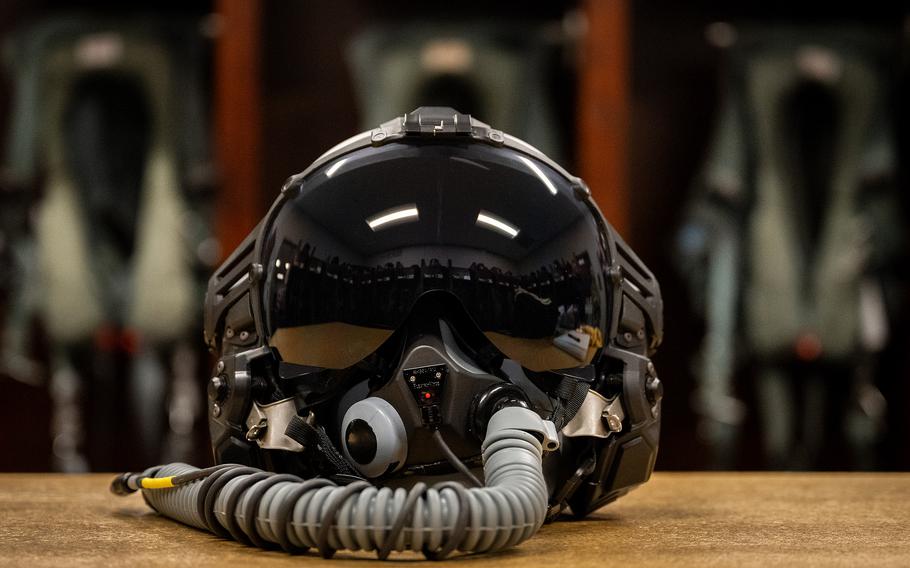
The Air Force’s Next Generation Fixed Wing Helmet sits ready for another testing at Eglin Air Force Base, Fla. The 46th Test Squadron engineers have begun developmental testing on NGFWH with F-22 Raptor pilots while the aircraft are stationed at Eglin. These tests mark the second round of developmental testing since the Air Force announced the new LIFT-manufactured helmet last year. (Samuel King Jr./U.S. Air Force)
(Tribune News Service) — Air Force helmets offer pilots more capabilities than ever — greater visibility, mounts for night-vision goggles and much more.
But they also offer their share of challenges, including fatigue with long use and even the possibility of injury when pilots perform high-speed maneuvers or eject from planes.
Dayton-area engineers and Cedarville University students have examined the problem. Three Cedarville senior engineering students worked on the issue with an Air Force accommodations group at Wright Patterson Air Force Base in a capstone project in advanced biomechanics technology before they graduated last month.
Jennifer Whitestone, chief scientist for Fairborn defense contractor STI-TEC, was pleased with how the students rolled up their sleeves and got to work.
Whitestone has worked with the Air Force since 1987. She has seen plenty of design students from different universities over the years.
“I can tell you, hands down, this is the best team of students I’ve ever worked with,” she said.
The Cedarville students did their homework, diving deep into the literature to see what previous engineers have done, she said.
The problem is relatively straightforward: As capabilities are added to helmets, so are weight and mass. And that shifts the helmet’s center of gravity — or “cg,” as students sometimes call it.
That has consequences for a pilot’s neck and back, particularly for female pilots, some of whom are smaller and lighter than male counterparts, Whitestone said.
“When you’re talking about dynamic scenarios, ejections and high-G maneuvers, then you’re really putting an extraordinary amount of torque on the neck” and the upper back, she said.
There’s also the matter of fatigue when simply wearing a relatively heavy helmet for long periods.
“How do we make it so it’s tolerable for the airman,” Whitestone said. “And ultimately, that’s what we’re here for.”
‘We really went into the weeds’
Josiah Zurick, a Cedarville graduate planning to work for Procter & Gamble in Lima as a process engineer, worked on the project. His goal was to advance the technology, but in a way that worked for pilots.
Zurick said the group used data from CT scans of cadavers provided by the Air Force, analyzing “slices” of CT images of cadaver skulls to better understand the human head.
The idea was to get a better read on where a head’s center of gravity is.
“We really went into the weeds of that,” said Zurick, 22, of Middlefield, Ohio.
Next year, a new team of Cedarville students will continue this work. Zurick said one goal is to not be forced to calculate a specific individual center of gravity for each pilot. The goal is to take just a few key measurements that will “clue us in on where the center of gravity will be.”
Whitestone said she and her team aren’t designers. They make recommendations and offer insights, not new designs, she said. She and her colleagues have looked at ejection seats, body armor, at an array of issues pilots need to deal with, such as bladder relief solutions for women pilots during long sorties.
Work will continue, particularly as new capabilities are added and new needs arise.
“I can keep a group of students busy for years to come,” she said.
Cedarville graduates Thaddeus Krueger, of Beavercreek, and Kimiye Wenger, of Lititz, Pa., were also part of the project.
“When we were given this two-year project, we knew it could become a game-changing helmet for our Air Force pilots,” Krueger — who has been accepted into an Air Force flight training program — said in a statement from Cedarville. “I was really invested in this project because anything that we can do to keep our pilots safe is worthwhile.”
“Countless moments of frustration have ultimately improved our communication and organizational skills,” Zurick said. “But we have a passion to see this project become a reality.”
(c)2024 the Dayton Daily News (Dayton, Ohio)
Visit the Dayton Daily News (Dayton, Ohio) at www.daytondailynews.com
Distributed by Tribune Content Agency, LLC.